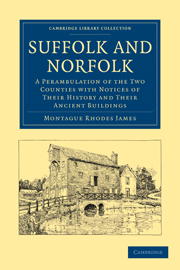 Suffolk and Norfolk
Suffolk and Norfolk Summary
BURY ST. EDMUNDS AND ENVIRONS
We will enter Suffolk from Cambridge by the Newmarket line. Within reach of Newmarket (of which I have nothing to say) is Exning, with St. Mindred's Well, described above (p. 14), and also another remarkable little place which until recently was in Suffolk, but now I believe belongs to Cambridgeshire, Landwade, long the seat of the Cottons—off the road, and consisting merely of church, ancient farmhouse, and moated site of a large mansion. The church, a cruciform building of 1445, is unrestored and little used, and contains good woodwork—roof, seats, screen—and considerable fragments of fifteenth-century glass: a St. Margaret is very notable; there are also remains of a series of Apostles.
Reverting to the Newmarket-Cambridge line we observe that on the left—northwards—we soon get into the open heathy country, of which Mildenhall is the centre, and which borders on the fen; and on the right—southwards—find a more hilly and wooded region containing the highest ground in Suffolk: 420 ft., in the parish of Rede, is the county's best achievement. Of places near the line, Kennett on the north has recently discovered wall-paintings: one of the Three Dead and Three Living, a memento mori subject which may well have become popular in the years after the Black Death, though it was invented earlier.
- Type
- Chapter
- Information
- Suffolk and NorfolkA Perambulation of the Two Counties with Notices of their History and their Ancient Buildings, pp. 32 - 114Publisher: Cambridge University PressPrint publication year: 2010First published in: 1930
